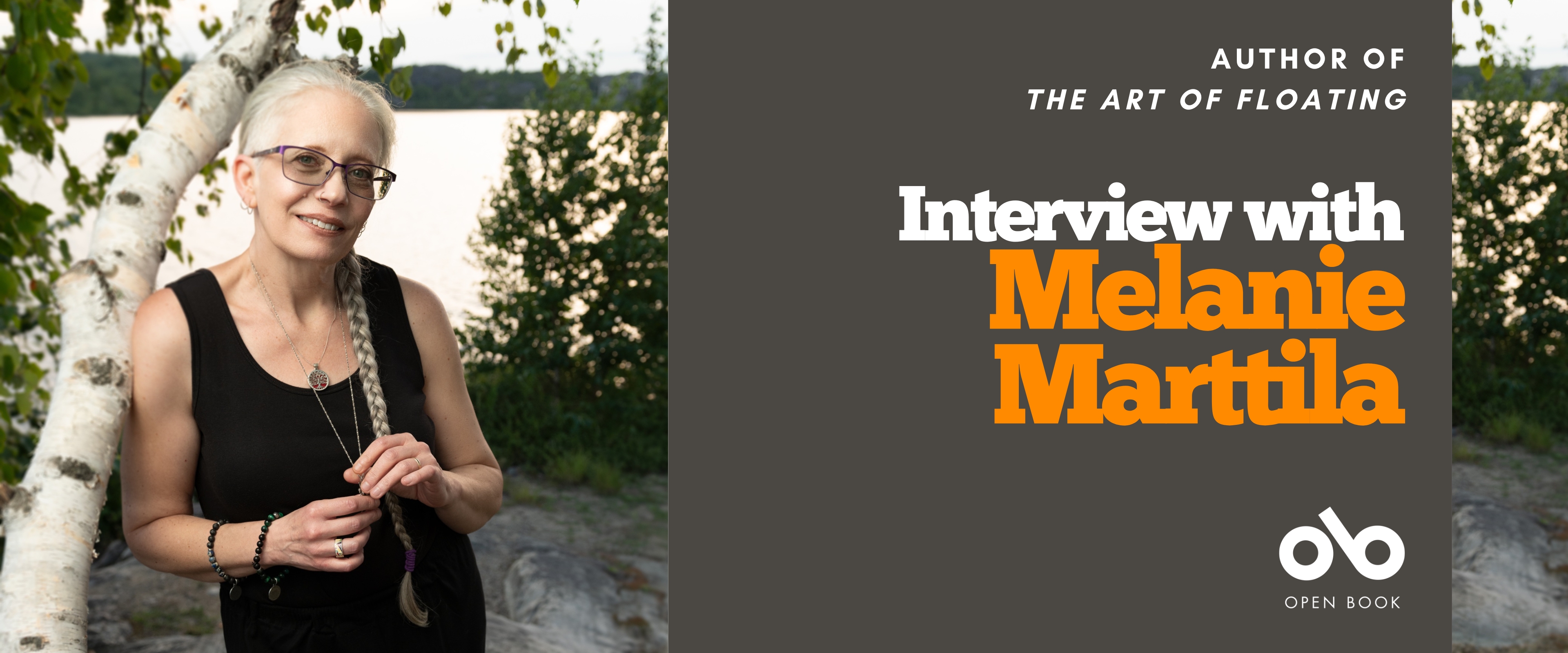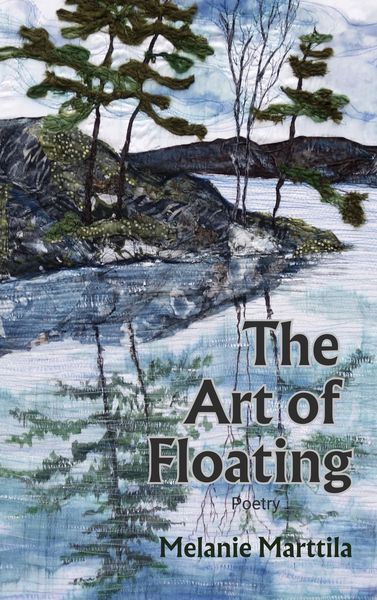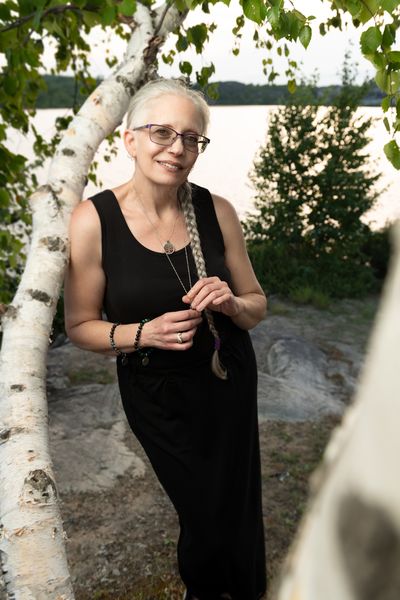Melanie Marttila Shows the Reader How She Moves Through the World in The Art of Floating
Inspired by the natural world and landscapes of northeastern and southwestern Ontario, and by personal, intimate moments in a person's life, Melanie Marttila has written a new collection of poems that focuses on the minuscule and the massive through careful lines and powerful images.
The Art of Floating (Latitude 46 Publishing) is dedicated to Marttila's father, and the impact that his experiences and teachings had on her life is plain. Her work reflects significant personal journeys to find beauty and peace in the world, and in her own body and mind. Just as her father could float perfectly in the water, Marttila's poems reflect the way that she has learned to move through the world, and float atop the most turbulent currents.
In this Line and Lyric interview, Marttila talks further about the process of assembling the collected poems in the book, and the ways that she crafts these pieces, honing in on poignant moments with each line and phrase.
Open Book:
Can you tell us a bit about how you chose your title? If it’s a title of one of the poems, how does that piece fit into the collection? If it’s not a poem title, how does it encapsulate the collection as a whole?
Melanie Marttila:
When I was shopping the manuscript, its working title was dew on spiders’ webs, after a line in one of the poems, “The Scent of a Spring Rain.” When the manuscript was accepted for publication, the title was one of the first required changes identified. It was nice enough, but what did it mean?
It wasn’t until I was working with Tanis MacDonald on editing and reordering the collection that we set about looking for a more appropriate title. We discussed several options of which The Art of Floating was one. “The Art of Floating” is also the title of what is now the central poem of the collection as well as the section it appears in. It’s meaningful in multiple ways.
My father died of congestive heart failure in 2011 at the age of 71 after a lifetime of poor physical and mental health. He spent the last year of his life being shuttled from the psychiatric unit to the step-down unit to alternative level of care and finally a nursing home. At his funeral, I shared the story of his nigh on miraculous ability to float—he could literally lie back on the water like it was a bed and put his hands behind his head, completely at ease. And I read the poem. I still imagine he floated peacefully into the afterlife, just like that.
I have also been on a mental health journey on which the most recent stop has been my late-in-life diagnosis of autism. One of the principal ways I regulate is to walk my dog, and when I walk my dog, I am often inspired by what I see of the natural world. I love the water and live in a city where several lakes are within walking distance. And the sky. I am forever taking pictures of clouds, sunrises, sunsets, rainbows, sundogs, pillars, and the moon. Always the moon.
While my journey has been different from his, my father taught me a lot about how I wanted to move through the world and how to stay afloat in it.
Your CanLit News
Subscribe to Open Book’s newsletter to get local book events, literary content, writing tips, and more in your inbox
OB:
Did you write poems individually and begin assembling this collection from stand-alone pieces, or did you write with a view to putting together a collection from the beginning?
MM:
I have been writing poetry since the mid-1990s and have had my poems published since the late-1990s. The Art of Floating is very much a collection of my poetry to date and so they are all stand-alone pieces. In the early stages I arranged them in thematic or geographic groups: Windsor poems, northeastern Ontario poems, moon poems, relationship poems, dream poems, science poems, etc.
Again, in the process of editing the collection Tanis MacDonald suggested moving things around and switching things up. Some poems were deleted, others were added. The sections still do adhere to some of the original groupings, but moving specific poems crystalized the theme of each section. It’s much stronger in its current form.
OB:
Apart from your editor and other publishing staff, who were the most instrumental people in the life cycle of this book? Did you share your writing with anyone while working on these poems?
MM:
Kim Fahner, past poet laureate of Greater Sudbury and current first vice chair of The Writers’ Union of Canada was instrumental in my poetic career. She was the one who first encouraged me to seek publication for my poems when we were both undergraduates at Laurentian University. We ran a small poetry journal for a couple of years. And when I first assembled my poetry manuscript, she reviewed it and suggested edits before I started to submit the collection to publishers.
OB:
What's more important in your opinion: the way a poem opens or the way it ends?
MM:
Can I say both? The ending is where the meaning of a poem comes together, but it often refers to the beginning, twisting it or revealing something about it. One doesn’t really work without the other. Mind you, most of my poems are short—some are only two or three lines—so I could argue that the whole poem is important. You can’t really look at a piece of a poem without considering the rest of it. If you could, it wouldn’t be a poem.
OB:
Was there a question or questions that you were exploring, consciously from the beginning or unconsciously and which becoming clear to you later, in this collection?
MM:
Because the collection is composed of poems previously published singly or in small groups, there wasn’t a conscious question or questions that propelled their creation in a collective sense. Taken as a whole, though, each poem in The Art of Floating arose out of a moment, something that touched me, inspired me, or affected me emotionally. Something that made me think or stayed with me long after the moment passed. Some poems spring fully formed from my head (not the head of Zeus). Some rattle around in my head for days, weeks, months, or even years before I commit them to the page. I possess a keen memory.
You could say that this collection is about me, how I see the world, and the connections I make between what I see and what that says about me as a woman entering middle age, a mental health consumer, an autist, and a creative. The Art of Floating is a reflection in verse on the last 25 years of my life.
OB:
What are you working on next?
MM:
In terms of poetry, I’m working on a few series. One was inspired by roadkill. I know. But shortly after I met Tanis MacDonald, I read Straggle, and one of the images that stuck with me was that of a deer hit by a car. Kim Fahner also writes about an accident-with-moose in one of her poems. Both got me thinking about the dead animals I’ve seen throughout my life. And then, I started thinking about the not-dead animals. The series has evolved. It’s now called Schrodinger’s animals, because you’ll have to read the poem to find out whether the animal is alive or dead.
I’m also writing a series about croning, the process of entering the second half of life and the changes that requires. In another series, I’m exploring what I’ve learned about my life since my autistic confirmation. I might roll those poems into a hybrid memoir. I even have a working title, The Autist’s Orrery. And I’m also writing about fairy tale sisters.
They’re just the various directions my creativity is leading me these days.
I’m also working on a speculative fiction novel, a piece of short fiction for an anthology call, and finding time for revisions on a novella and for drafting a historical fantasy.
______________________________________________________
Melanie Marttila captures the solace and healing she has found in the terrestrial landscapes, flora, and fauna of northeastern and southwestern Ontario while balancing the ebbs and flows of her mental health. There is similar reprieve in looking skyward as she shares in beautifully crafted poems the reflections of celestial patterns on moods, perceptions and relationships. Through the often insignificant and mildly miniscule moments in life, Marttila demonstrates the truth and hope that lie within each, whether connecting with land or sky. The Art of Floating is dedicated to the poet's father, who taught her how to surrender to and survive the rough waters of mental illness.






